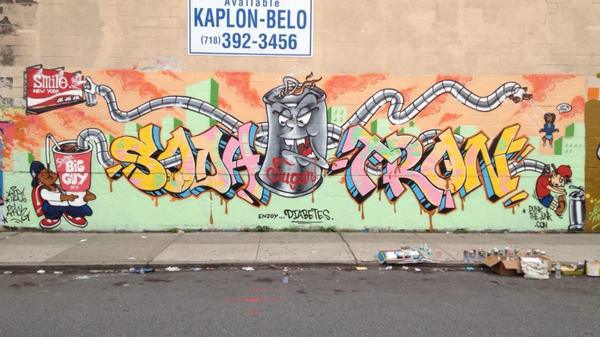 Nov. 7, 2014 Election Outcome: Historic passage and precedent of Berkeley vote on soda tax; synopsis article via SF Gate on why Berkeley passed a soda tax and SF didn’t.
Nov. 7, 2014 Election Outcome: Historic passage and precedent of Berkeley vote on soda tax; synopsis article via SF Gate on why Berkeley passed a soda tax and SF didn’t.
Oct. 8, 2014 Update: NYTimes’ Mark Bittman and Mother Jones both weigh in on the politics of the soda tax, which has vaulted to $9.1 million “Big Soda” (ABA) spending combined to try to crush the measure in SF (7.7M) and Berkeley Bay area according to today’s SF Chronicle. Wow. Speaks volumes about the willingness to put profit over public health and kids’ wellness.
Original Article: Oct. 2, 2014 Childhood Obesity Awareness Month was packed with whiplash inducing moments of “say whaaa?” contradictions involving school health and soda policy that often uplifted and inspired only to land flat and leave a tinny taste, kind of like the artificial sweeteners in diet drinks. (which we now know are not so effervescent and sparkling either according to new studies that look at the role of diet drinks in glucose intolerance and blood sugar spikes)
While media continues to trumpet congratulatory headlines about soda industry’s pledge to reduce each American’s calorie consumption in sugary drinks by 20% on average by 2025, health advocates continue to shoulder shrug that it’s simply “promising what is happening anyway” via slack sales and market downturn.
Don’t get me wrong, I heartily embrace the promises of smaller portions, low- and no-calorie drinks, and using “big soda’s” promotional clout to educate consumers and encourage them to reduce the calories they are drinking, but having spent 25 years in branding and new product development, (albeit benign ones) we have to look at what’s actually ‘transforming’ and what’s perceived as transforming as we move forward. We’ve got to stop placing profit over public health, period.
Important sounding headlines that herald industry’s commitment to “transforming the beverage landscape” prompt wild applause and appeal…but, unfortunately, it’s naïve to view the news without framing the larger context and the impact on kids’ health.
What IS “transforming” is the marketing message…
And frankly, I think we’re in for MORE, not less beverage marketing. For starters, all the soda pledges to “educate” consumers are really just a canned excuse for more marketing, repositioned in a corporate responsibility sleeve.
To me, the soda giant ‘transformers’ conjure visions of the behemoth toys in the movie…
Their ability to be ‘large and in charge’ crashing through policy and practices, tapping into new and unusual workarounds and using unique promotions to target youth with even BIGGER marketing budgets while bubbling about the great work they’re doing for public health is surreal…In fact, the ‘sky’s the limit,’ quite literally, with “dronevertising.”
Check out this GPS mobile app meets ambient advertising ploy in Sprite Zero’s Refresher. I think we’ll see much more of this type of “guerilla marketing” positioned as “kids’ choice” with freebies and gimmicks dangled and deployed with merciless precision.
As a reminder, nothing the soda giants create is accidental…
There are no doubt NeuroLinguistic Programming dynamics at work along with brilliant emotional campaigns…like Coca-Cola’s happiness and kindness empathy efforts. From hugging vending machines to goosebump inducing ‘awww’ moments like Coca-Cola’s previous drone-based effort these ads have got your number, backed by neuroscience and persuasion research.
Granted, a soda exec’s job is to push product for profit…period.
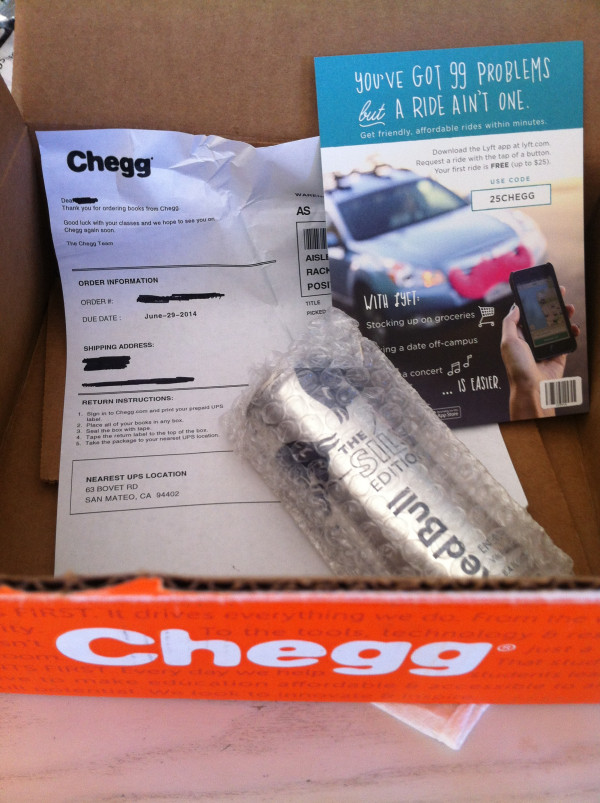 We certainly found out “how low will they go” when Gatorade told kids to avoid water in their marketing attempts to hawk hydration. Needless to say, I’m dubious about the ‘transformation’ to healthier offerings with results like that. And whether industry is using ambient advertising, surprise gifts, content marketing, good will, or coolness caché, I think we’re in for an amped up beverage blitz.
We certainly found out “how low will they go” when Gatorade told kids to avoid water in their marketing attempts to hawk hydration. Needless to say, I’m dubious about the ‘transformation’ to healthier offerings with results like that. And whether industry is using ambient advertising, surprise gifts, content marketing, good will, or coolness caché, I think we’re in for an amped up beverage blitz.
My own recent experience of the latest tactics came in the form of school textbook company Chegg “partnering” with Red Bull energy drink and Lyft. (energy drinks mixed with alcohol are a youth public health problem already, we don’t need an extra prompt with a ‘ride’ cue and study aid to boot)
My own teen’s collegiate package arrived with a bubble-wrapped can of the carbonated cough syrup tasting crud…totally unsolicited. The freebie find of course got kids ‘atwitter,’ with buzz brewing via word of mouth throughout student enclaves fast.
Sure, a few were bristling with annoyance akin to the Apple U2 album auto-gifted in the cloud, but the point is, beverage companies are sharpshooters in their target marketing and an “opt-out” vs opt-in practice is NOT what we need in public health.
That goes for the heavy content marketing strategy that Coke, Pepsi, and Red Bull partake in too…If this is the direction ‘transforming’ the beverage landscape, we’re in for a zero sum game.
Even though at first blush all this talk about “initiatives” and the need for alternative low-cal beverages APPEARS industry is nudging toward conceding soda is unhealthy it’s really more of a “reframe” to overhaul strategy, create “line extensions” and repackage and resell everything as new and improved “health and wellness soft drinks.” Watch.
From energy drinks and unregulated functional supplements to sports drinks, sparklers, and the up and comer on the global scale, “ready to drink” (RTD) teas emerging as the next ‘big thing,’ health and media literacy advocates will need to amp up their own game of ‘spot the spin.’
Though it’s hard to stay ‘one step ahead’ in media literacy training to teach kids what to watch for, from athlete/celebrity doublespeak (shilling soda while not allowing it on the set or the court) to dangling scholarship dollars and ‘giving back’ to the community with wellness programs and sports team support (see School Sit Ups Sponsored by Soda and Snacks) the new branding will no doubt go from overt to covert targeting tactics, including ‘better for you’ repositioning under the ‘wellness’ health halo and probably more ‘white label/unbranded’ viral word of mouth/peer to peer proxies. So let’s just get real about the childhood obesity dialogue…
Soda giants know exactly what they “need to do” but there’s no way in hades they’re going to do it…
As Yale Rudd Center for Food Policy & Obesity’s Patrick Mustain wrote in Scientific American,
“People who actually study these things–medical, public health, and public policy professionals–have recommended a number of evidence-based strategies to meaningfully reduce sugary beverage consumption and improve health.
Strategies like reducing marketing of sugary beverages to children, enacting size limits on sugary drinks, and taxing sugary beverages to more accurately represent their cost to society.
These efforts are all aggressively being undermined by the beverage industry, because the last thing the industry wants is for people to actually stop drinking its most profitable products.”
Yup. Again, I’ll go a step further to pull back that curtain of Oz and remind that these “new education initiatives” like energy balance rhetoric and attempt to cajole social sharing of selfies with MyMixify will in fact INCREASE not decrease the marketing of soda keeping it top of mind, straight out of an advertising playbook.
Look no further than Coca-Cola, for example, who hiked its global ad budget by $1 billion over the next three years, up from $3.3 billion in 2013. That’s a lot of liquid candy that will be marketed strategically, so it’s a “personal responsibility” issue that they’ve “done their best” to curb.
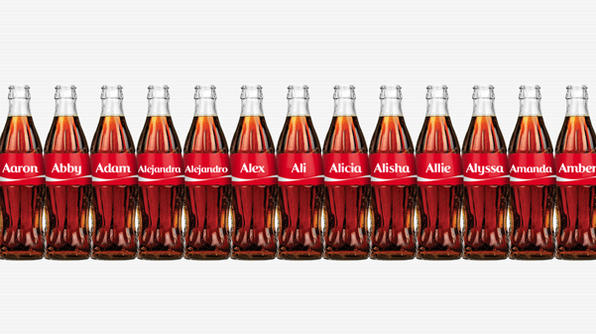 Can ‘less product’ mean even more branding? Hmn.
Can ‘less product’ mean even more branding? Hmn.
Coke just used 250 of the most popular first names for teens and millennials (while, um, not marketing directly to kids of course) in their latest “Share a Coke” name-dropping campaign, while tossing in the “limited time only” urgency tactics creating a “temporary” supply. Suddenly, they’ve got a bum’s rush to snag ‘em, and though Coke’s execs are already giving “serious consideration” to bringing back this successful campaign that popped up their droopy sales since no one’s sure if or when the names will ‘be back’ the narcissistic floodgates have been opened and sodas are now being auctioned on ebay. Go figure.
 Fun health and media literacy opportunities abound to teach kids about stage-crafting and politics and what’s hidden in plain view, like the ‘faux political rallies’ funded heavily to the tune of $2M to stop the soda tax, or the heartstring commercials running that claim the tax would hurt vulnerable black/Latino communities (who in fact happen to be a huge double down demographic risk bracket for obesity, largely due to big soda’s relentless pursuit to hook minority youth on the sugary addictive low cost junk food meal deals and dollar days).
Fun health and media literacy opportunities abound to teach kids about stage-crafting and politics and what’s hidden in plain view, like the ‘faux political rallies’ funded heavily to the tune of $2M to stop the soda tax, or the heartstring commercials running that claim the tax would hurt vulnerable black/Latino communities (who in fact happen to be a huge double down demographic risk bracket for obesity, largely due to big soda’s relentless pursuit to hook minority youth on the sugary addictive low cost junk food meal deals and dollar days).
If you need extra umpf for media literacy “show-n-tell” tactics, I highly recommend the substantive CokeSpeak.org. They’ve got a sensational mindmap graphic of key phrases (with deeper critical thinking in core categories like “Top 10 crooked arguments,” mogadon words, false truisms, the dissembling wheel, the infinite cycle and more).
Parents and wellness educators can have a blast challenging students to create DIY ads and apply the newly learned skills to the emerging soda marketing health halo that’s being deployed collaboratively.
The CokeSpeak.org site also has a sharpshooter section called “Denialism in Public Health” featuring Professor Simon Capewell’s (Chair of Clinical Epidemiology at the University of Liverpool) classic S.L.E.A.Z.E mneumonic which applies to critical thinking even beyond the health harms of big soda, processed food and tobacco as it’s usable in multiple forms of academic debate. It’s brilliant.
The visual insight of SLEAZE is a tactical tool right up there with my favorite Berkeley Media Studies Group ‘pink elephant’ reminder NOT to reinforce your opposition’s arguments.
Both are handy for a writer’s war-chest in the ongoing whack-a-mole game of big food companies putting profit over public health.
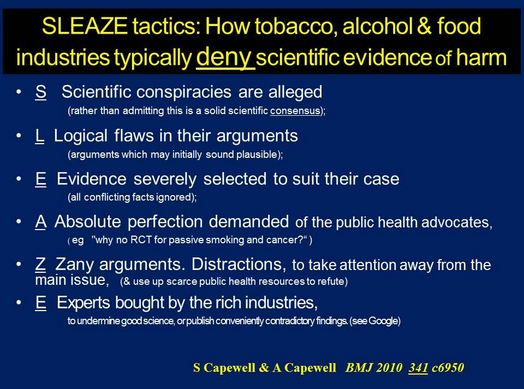 Finally, my favorite soda specific cheat sheet for a parents and practitioners primer comes from the Prevention Institute, citing in a straightforward chart:
Finally, my favorite soda specific cheat sheet for a parents and practitioners primer comes from the Prevention Institute, citing in a straightforward chart:
“What they say vs what they do”…
 This could use some updates based on the new beverage ballyhooing of the ‘reduced calorie’ initiative, so hopefully we can all compile a fresh “perception vs reality” add-on list…
This could use some updates based on the new beverage ballyhooing of the ‘reduced calorie’ initiative, so hopefully we can all compile a fresh “perception vs reality” add-on list…
Here’s a triple play of informative posts on soda and school “smart snacking” issues to get up to speed on what’s new and improved and what’s ‘one step forward two steps back.’
As you read through the trilogy of soda and smart snacking spins, keep a pen handy to jot down “What they say vs what they do”…and toss it in the comments section. I’ll compile it in a subsequent piece and see if Prevention Institute can add-on to their excellent graphic…with ‘new and improved’ instances of beverage backwash.
The first poignant post on payola, regulation dodgeball, and silencing critics through politics could easily be plucked from a House of Cards TV script (real life edition).
Written by Yale Rudd Center’s Patrick Mustain, he gives context and a helpful snapshot of the soda/obesity lens using sardonic wit and ample strike-throughs to mock (er, make) his points in Scientific American.
His candor and pithy prose is a scathing indictment of the antics of the soda giants, and would be completely hilarious if it weren’t so tragically true.
Next, the satirical post written in the voice of ‘big soda’ by national food policy activist Nancy Huehnergarth is a keeper, outlining the multiple conflict of interest problems with wince-worthy incredulity.
Her more recent policy piece calling out the attempts to water down nutritional standards at schools goes straight to The Hill giving a verbal lashing to the gobsmackingly surreal, wrong-headed undermining of healthier school food.
Evidently Rep. Ted Poe (R-Texas) is trying to upend and dismantle the ‘ink is still wet’ USDA nutrition rules for schools with a misleading, deceptively titled “BAKE SALE Act” (which stands for “Bringing Awareness and Knowledge to Exempt Schools Against Legislative Encroachment Act”) His cruddy acronym capers are media bait for pundits baiting outrage with surface slams to be parlayed into vapid sound bites about school parties and cupcake wars, which is not only untrue, deflective and off topic, but a SLEAZE device straight from the letter Z for ‘zany arguments and distractions.’
Here’s the actual Bridging the Gap, RWJF state by state graphic on various bans and policies in case anyone is worried about regulatory overkill and cupcakes being compromised…they’re not. (Which is fine by me as I’m not a ‘ban fan’ due to the forbidden fruit factor) That said, I also feel junk food fundraisers send crummy cues to kids and would rather see smarter suggestions coming out of our schools, like the ‘color runs’ and healthy fundraisers percolating out of the 9/26 #FoodFri Mom’s Rising Tweetchat.
Finally, the third truth-telling health literacy post comes from stellar #MomsNotLovinIt food marketing crusader Casey Hinds who has given permission to crosspost her “Soda Wolves” piece in full below, which notes the gaping holes missed by herds of sheeple as millions of additional marketing is spent with ‘new and improved’ tactics to put forth the ‘lower calorie’ fare. This springboards from where I started earlier in this piece on watch-worthy health halos with excellent links to au courant research, including the recent studies showing diet sodas have come under fire for fouling up blood sugar as well.
Also, for media and health literacy educators, here are a few of my own ideas to counter-market and deconstruct “big soda” tactics and unhealthy food marketing…This was presented at the National Association for Media Literacy Educators summer 2013.
Hope it’s…’transformative.’ Enjoy!
Soda Wolves Disguised in Sheep’s Clothing
“magically, when they would turn twelve, we’d suddenly attack them like a bunch of wolves“
I was reminded of that quote from a former top marketing executive at Coca-Cola when I saw the recent news about soda companies pledging to reduce calories. Last year, the Alliance for a Healthier Generation (AHG) announced a partnership with McDonald’s to “leverage their market share and cultural relevance to help inform and influence the way families eat outside the home.” This year, they made a similar agreement with Coca-Cola, Pepsi, and Dr. Pepper.
When the McDonald’s agreement was announced, I shared my concerns that it would undermine parents working to reduce the amount of fast food marketing aimed at kids. Since then, McDonald’s has rolled out even more marketing in the form of a new Happy Meal mascot character and a new social media campaign for Ronald McDonald. The soda companies are also using their agreement with AHG to amp up their marketing to children under the guise of help.
Enter: Mixify. A new project from America’s beverage companies that’s all about making balance easier.
This is the same kind of energy balance language soda companies have used before to blame the victims they hooked on products engineered to be addictive. It also feeds on the developmental vulnerabilities of youth by emphasizing the importance of how they look.
Because at the end of the day, finding balance keeps you looking and feeling good. And that means achieving more of what really matters—better selfies.
With Mixify, Big Soda seems to have taken notes from Big Alcohol’s abuse of the “drink responsibly” message as a marketing tool.
The “drink responsibly” slogan also serves as a public relations distraction for alcohol corporations fighting evidence-based, effective policies such as increasing alcohol taxes, restricting alcohol advertising, and maintaining state control of alcohol sales.
As we learned from Joe Camel, the kind of help parents need from companies selling harmful products is for them to stop marketing to our kids. Instead, parents are left to fend off celebrities using their fame to shill soda. There’s pop star Taylor Swift in a new Diet Coke campaign aimed at making us forget about that pesky new research showing artificial sweeteners may raise our risk for diabetes. Athlete LeBron James follows the hypocrite diet by eschewing sugar and carbs while marketing soda and fast food to children.
As that former Coke executive put it, “The game is rigged by the power of the soft drink industry and how much money they put against all the competition in that space.” This infographic from the Center for Digital Democracy shows how the game is rigged even more for African-American children. Latino children also face this “double dose” with both mainstream and targeted marketing.
People are seeing through Big Soda’s latest “slick move to gain better favor with consumers.” Public health expert Kelly Brownell commented, “These companies are under fire, and promises without substance will not help.” What will help? A soda tax on sugar sweetened beverages. Soda companies know this too and are spending unprecedented amounts to defeat these measures in California.
The industry is all in, pouring at least $2 million into the fight already, to hold its perfect record.
I urge Berkeley and San Francisco voters to show their support for parents working hard to raise healthy kids and vote yes on the soda tax measures in November. It will send a strong message to the soda wolves and will have ramifications far beyond Northern California.
“This isn’t a local campaign. This is a national campaign. If we pass ours, other cities will have it on the ballot.”
Casey Hinds’ post in the shadow box above originally appeared in US Healthy Kids. Casey Hinds works to make a healthier food environment for children and instill a love of physical activity. Read more at ushealthykids.org and follow her on Twitter @caseyhinds
Shaping Youth disclaimer on the soda/political voting: Shaping Youth is a nonpartisan, non-religious based, nonprofit/self-funded entity and cannot endorse any given initiative due to our bylaws.
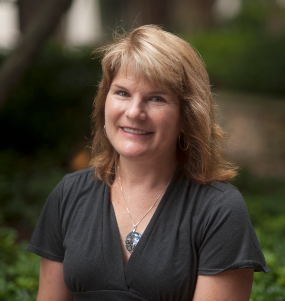









Speak Your Mind